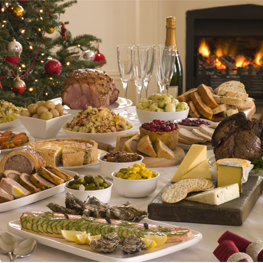
When most people think of the holidays, visions of festive foods dance in their heads. And if you’re hosting this holiday, you undoubtedly want to create a special dinner for family and friends. The only problem is that you’re likely to have at least one guest with a special diet. Millions of people have some kind of food allergy and others have changed their diets to combat heart disease, diabetes, or cancer. And still others are trying special diets like plant-based and Paleo. If you hope to be the host with the most, creating a meal to satisfy everyone can be stressful. Never fear! The following 10 tips have you covered. They include practical, easy ways to make any holiday dinner a hit.
1. Inquire when you invite. When sending out your e-Invites, include a query asking guests to provide you with their information regarding any allergies or restrictions when they RSVP. And to help with organization and accuracy if feeding a lot of people, you might want to make a spreadsheet or map out your table of guests with what food specialties are required and for whom.
2. Be careful not to cross-contaminate. Cross-contamination occurs when a small piece of a food allergen gets into another food accidentally. Wash hands frequently, keep spoons for each dish separate, and be aware of cross-contamination for more than just serving utensils. If you chop an ingredient that is an allergen on your cutting board, blend it together in a mixing bowl, or bake it on a cookie sheet, be sure to wash these items also, or you are at risk of cross-contaminating food.
3. Keep wrappers from pre-packaged foods. There are a plethora of options for holiday dishes in the freezer and specialty aisles of the grocery store. Save time and sanity by using them, just keep the packaging on-hand so that you can tell guests confidently what the ingredients are.
4. Use simple substitutes. The key to serving a delectable meal and keeping everyone safe is swapping ingredients they can’t have for ones they can. For example, one easy substitute is to use vegetable broth instead of chicken or beef broth. This keeps the food friendly for vegans. Or you can substitute olive oil for butter for someone who is allergic to dairy. Find recipes that sweeten desserts with applesauce, dates, or bananas. Risotto or quinoa can be substituted for or served in addition to stuffing so you can offer a gluten-free option. And sometimes less is more. If you completely delete a troublesome ingredient out of a recipe, and you can’t tell a distinct difference between the two, go for that option.
5. Make two versions of a favorite dish. It’s easy to make some dishes two ways. You can make stuffing and rolls with gluten and without gluten. You can make a cheesy broccoli casserole or creamy green bean casserole and versions of both without dairy. Before you add the cheese or cream, take out some of the vegetables and make a simpler version that is safe for those with dairy allergies.
6. Create some ‘everybody’ dishes. It’s a good idea to create plenty of sides that are friendly for everybody, including surprise guests. An aunt’s work schedule may change and she can come after all. Your nephew may call the day before and ask if he can bring his new girlfriend, and she’s a vegetarian. Veggies without butter, soups without dairy, or meat or fruit salads sweetened with natural alternatives are a great way to fill up the table and give everyone a chance to share the same food fare.
7. Label dishes with place cards. When friends and family that haven’t seen one another for months or years get together, it’s easy to forget to share about dietary restrictions with all the laughter and talking. Food labels not only keep your guests informed about the food, they add an exquisite touch to your table setting. Make food labels ahead of time to go with each dish. Or make a label station with decorative markers close to the food for guests to label food, especially those that contain the most common allergens: dairy, eggs, fish, shellfish, tree nuts, peanuts, wheat, and soybeans.
8. Serve food buffet-style. Serving food buffet-style with labels is a good way to let diners know what they can and can’t eat. Be careful to keep spoons with the right dishes, or better yet, label serving utensils with the food name each one goes with. Put a small plate or spoon rest in front of each dish so that juices and food bits are contained.
9. Don’t try to do it all. Don’t be afraid to ask your guests to bring a dish to share. Maybe you prepare the meat and bread and have everyone else bring a side. It can add to the fun of eating a meal together if your guests can expand their culinary tastes and bring different styles of cooking to the celebration.
10. Be open to new traditions. Holiday meals are steeped in tradition and when diets change, it’s hard to let go of familiar dishes. But you never know, you might actually like risotto instead of stuffing or a lighter, healthier version of sweet potato soufflé and scalloped potatoes. Don’t be afraid to embrace some new traditions as you cook for friends and family, and you
will keep your holiday table open and warm.
Janeen Lewis, M.Ed., is a teacher, writer, and mom to Andrew and Gracie. She has been published in several parenting magazines and more than a dozen Chicken Soup for the Soul anthologies.
Calgary’s Child Magazine © 2024 Calgary’s Child